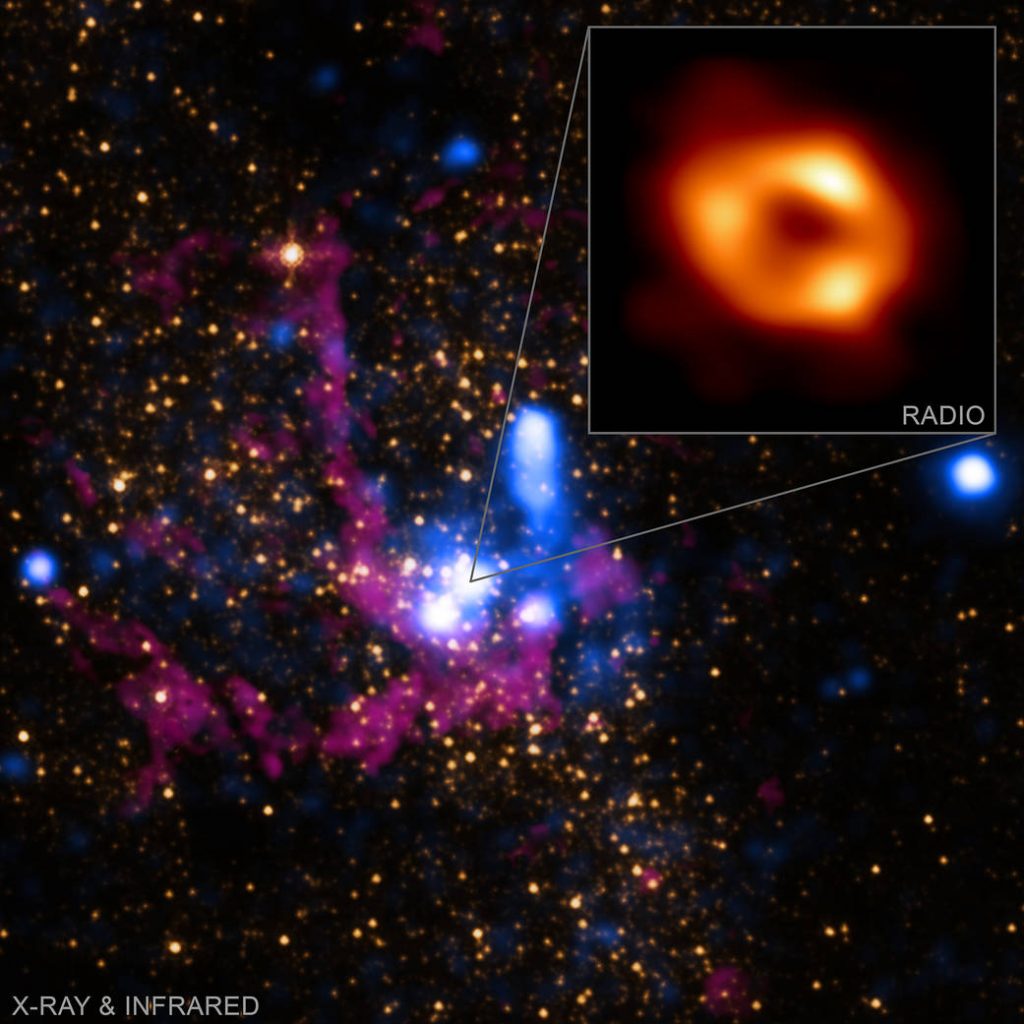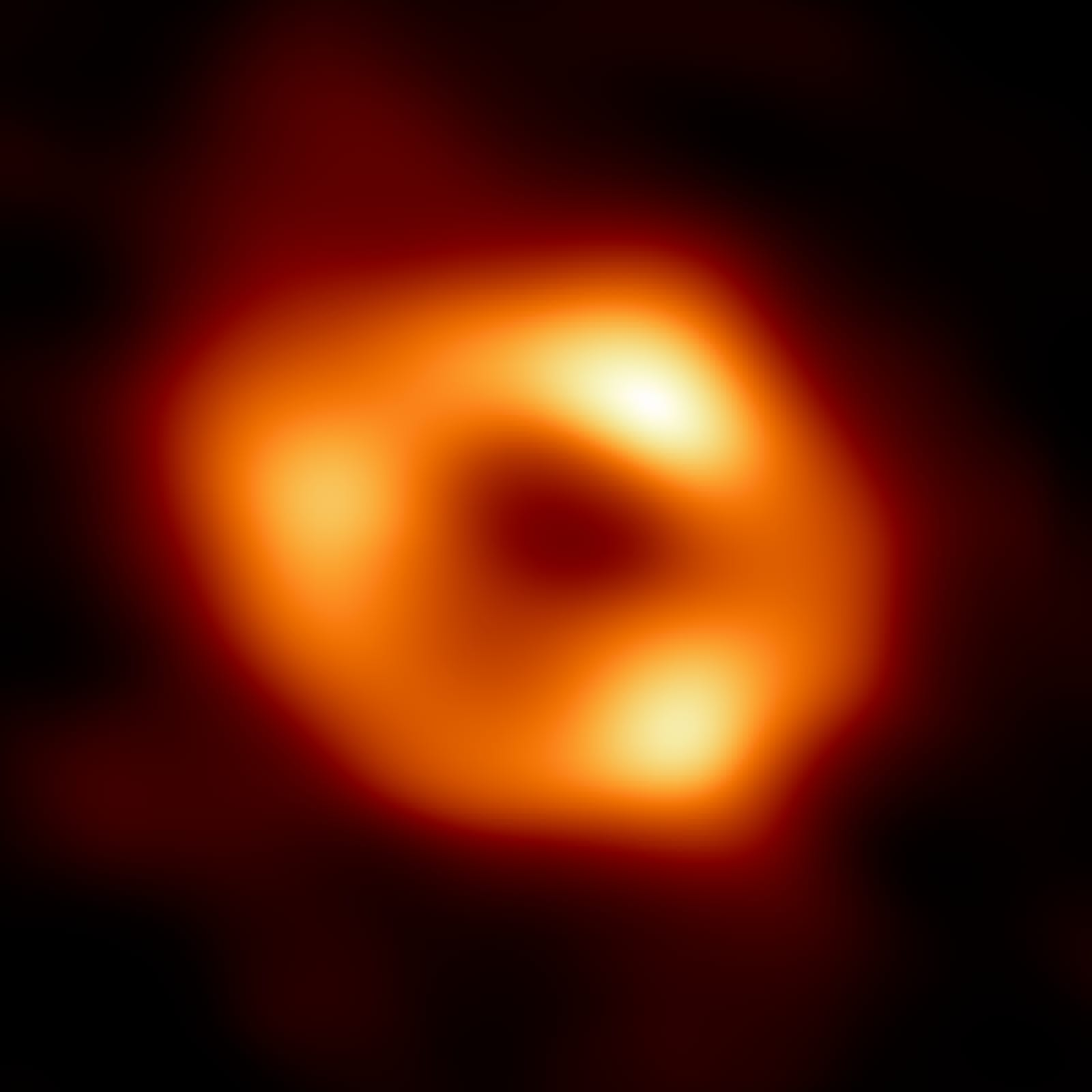A group of other telescopes, including three NASA X-ray observatories in space, are watching while the Event Horizon Telescope collected data for its astonishing new image of the Milky Way’s supermassive black hole.
These data are being used by astronomers to understand more about how Sagittarius A* black hole at the center of the Milky Way galaxy interacts with and feeds off its environment some 27,000 light years from Earth.
What Did The Event Horizon Telescope Observe?

When the Event Horizon Telescope (EHT) surveyed Sgr A* In April 2017 to create the new image, scientists from the partnership used equipment that detected multiple wavelengths of light to peek at the same black hole.
They combined X-ray data from NASA’s Chandra X-ray Observatory, Nuclear Spectroscopic Telescope Array (NuSTAR), and the Neil Gehrels Swift Observatory with radio data from the East Asian Very Long-Baseline Interferometer (VLBI) network and the Global 3-millimeter VLBI array, as well as infrared data from the European Southern Observatory’s Very Large Telescope in Chile for this multiwavelength observing campaign.
NASA Administrator Bill Nelson remarked, “The Event Horizon Telescope has taken yet another stunning image, this time of the massive black hole at the center of our own home galaxy.”
“Taking a closer look at this black hole will let us learn more about its cosmic repercussions on its surroundings, and it illustrates the international partnership that will lead us into the future and disclose discoveries we could never have anticipated.”
Related: Watch Sagittarius A* First Look Discovered At The Heart of Milky Way
What Was The Objective Of This Observation?
One of the main objectives was to catch X-ray flares, which are thought to be caused by magnetic processes comparable to those on the Sun but can be tens of millions of times more strong.
These flares occur on a daily basis in the EHT’s observation area, which is slightly larger than Sgr A*’s Event horizon, the point of no return for matter falling inward. Another purpose was to have a critical look at what’s going on at a bigger scale.
While the EHT result showed Sgr A* and the previous black hole it observed M87*, to be very similar but in a complicated way.
“If the new EHT image shows us the eye of a black hole hurricane, these multiwavelength data reveal winds and rain hundreds as well as thousands of kilometers beyond,” said Daryl Haggard of McGill University in Montreal, Canada, one of the multiwavelength campaign’s main scientists.
“How does this cosmic storm interact with, and potentially disrupt, its galactic surroundings?”
One of the most interesting aspects of black holes is how they absorb, devour, or even expel material orbiting them at near-light speed, a process known as “accretion.” This is how planets, stars, and black holes of all sizes begin and grow across the cosmos.
Related: Listen The Spooky Sound Coming From Inside A Black Hole
Significance Of These Photos.
Chandra photos of hot gas surrounding Sgr A* are important for accretion studies because they show how much material is captured by the black hole’s gravity from neighboring stars, as well as how much makes it close to the event horizon.
With existing telescopes, for any other black hole in the universe including M87*, no one has this essential information.
“Astronomers can mostly agree on the fundamentals that black holes have material swirling about them and that some of it run into the event horizon forever,” Sera Markoff of the University of Amsterdam in the Netherlands, another multi-wavelength observation coordinator, said. “We can go much further than this basic image with all of the data we’ve obtained for Sgr A*.”
How Did Scientists Observe These Data?
Scientists in the large international collaboration compared data from NASA’s high-energy missions and other telescopes to advance computational models that account for factors like Einstein’s general theory of relativity, magnetic field effects, and predictions of how much radiation the material surrounding the black hole should generate at different wavelengths.
What Was The Result Of This Observation?
The simulations and data suggest that the magnetic field around the black hole is strong, and the angle between the line of sight to the black hole and its spin-axis is small, less than 30 degrees.
If confirmed, this suggests we’re gazing down on Sgr A* and its ring from our vantage point rather than side-on, which is remarkably similar to EHT’s first target M87*.
“While none of our models exactly match the facts, we now have more precise information to work with,” said Kazuhiro Hada of Japan’s National Astronomical Observatory. “The more evidence we collect, the more accurate our models will be, and the more we will comprehend black hole accretion.”
The Spotting Observation Of The Event Horizon Telescope
During the EHT observations, the researchers also caught X-ray flares or outbursts from Sgr A*: a dim flare detected with Chandra and Swift, and a moderate strong one seen with Chandra and NuSTAR.
Chandra has previously seen X-ray flares of similar brightness, but this is the first time the EHT has simultaneously spotted Sgr A*, providing an unprecedented opportunity to pinpoint the causal process using actual images.
In few hours following the brighter X-ray flare, the millimeter-wave strength and variability recorded with EHT increases, a feature not seen in millimeter measurements a few days before.
The analysis and interpretation of EHT data collected shortly after the flare will be published in the future.
The results of the EHT team will appear in a special issue of The Astrophysical Journal Letters on May 12th. Papers II and V will cover the multiwavelength results in detail.
Conclusion
The Chandra programme is run by NASA’s Marshall Space Flight Center. The Chandra X-ray Center at the Smithsonian Astrophysical Observatory in Cambridge, Massachusetts, is in charge of science operations and flight operations.
The Swift mission is managed by Goddard in partnership with Penn State, New Mexico’s Los Alamos National Laboratory, and Dulles, Virginia’s Northrop Grumman Space Systems.
The University of Leicester and Mullard Space Science Laboratory in the UK, Brera Observatory in Italy, and the Italian Space Agency are among the other collaborators.
